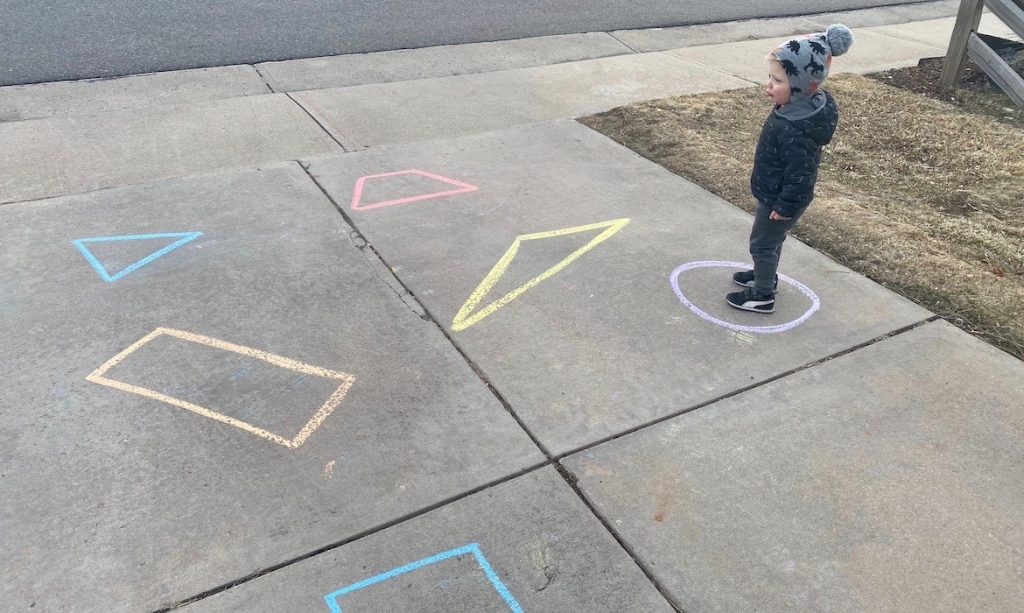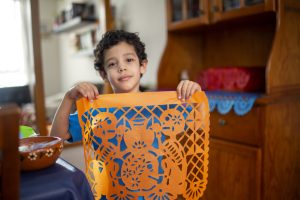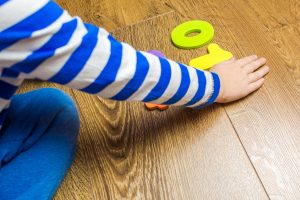- Don’t Burn Your Feet is a playful way for children to learn about shapes while also moving their bodies.
- Building knowledge around shape concepts involves more than just knowing the names of familiar shapes.
- This game can be adapted so children can practice and develop their shape knowledge.
How to Play
Don’t Burn Your Feet will get your child jumping around—inside or out—while exploring shape concepts. Find the instructions and ideas for making this activity easier or harder on the DREME for Teachers website. Here’s a summary of how to play:
Set up the game by making different shapes on the ground or the floor. The easiest way to make shapes is to use sidewalk chalk to draw on a driveway or sidewalk. If the weather is bad or you prefer to play inside, you can make the shapes by using masking, washi, or painter’s tape. You could also cut out or draw shapes on sheets of paper and put them on the floor.
To play the game, explain to your child that the ground is “hot lava” (they can imagine a volcano has just erupted!) and they have to jump on the shapes you tell them so that they don’t “burn” their feet.
Then, tell them different rules for what shape they should jump on. For example, for children just learning the names of shapes: Jump on the triangles—so you don’t burn your feet! For children ready for more of a challenge: Jump on shapes with three sides—so you don’t burn your feet!
Develop Early Geometry Skills
Many people wouldn’t consider geometry an important math topic for young children. However, learning about shapes sets the foundation for geometry skills. Shape knowledge not only lays the groundwork for geometry concepts that students will learn and build upon in elementary school and beyond, but it can also improve children’s number and arithmetic learning. [1]
Older toddlers start by being able to recognize common examples of circles, squares, and triangles. But young children’s shape knowledge can go beyond these familiar shapes. As their skills grow, they can recognize less-common examples of these shapes. They soon learn to identify sides and then corners or angles of shapes.
Once children can identify sides and angles, these skills support their ability to recognize less-familiar shapes, like hexagons, trapezoids, and rhombuses. As they did with familiar shapes, children will first recognize common examples of these shapes. Later, they will be able to recognize more challenging examples. Finally, children will be able to think about shapes in terms of their attributes, such as right angles or parallel lines. [2]
Personalize the Game for Your Child
You can support your child’s developing shape knowledge by adapting Don’t Burn Your Feet to make it more or less challenging. These adaptation ideas progress from early to advanced geometry skills.
- If your child is just starting to recognize a few shapes: Start with common examples of familiar shapes, such as circles, squares, and triangles. Then mix in more challenging examples of the familiar shapes. Also include shapes that are not the target shapes your child will be finding (e.g., ask your child to look for circles and squares, but also draw ovals and rectangles in the game space). Include figures that aren’t traditional shapes (e.g., a “rectangle” but with curved corners).
- If your child is starting to recognize sides or corners: Instead of telling your child to jump on a certain shape, tell your child to jump on shapes with a certain number of sides or angles (Jump on shapes with four angles!).
- If your child is starting to recognize less-familiar shapes: Start adding in 1-2 new shapes, such as rhombuses, hexagons, or trapezoids. Use a mix of telling your child to jump on certain shapes (Jump on the hexagons!), and to jump on shapes with a certain number of sides or angles (Jump on shapes with four angles!).
- If your child knows many of the less-familiar shapes and is starting to recognize shape attributes, such as parallel lines: Tell your child to jump on shapes based on their properties (Jump on shapes with a right angle! OR Jump on shapes with exactly one pair of parallel sides!).
Language and Math Skills Grow Together
In addition to helping your child develop early math skills, math games like Don’t Burn Your Feet can also promote critical thinking and language skills. Playing with a variety of rules and asking your child questions about their thinking can help build their language, logic, and problem-solving skills. Here are some ideas to get you started:
Shift between rules using different shape parts and numbers. For example, go from “shape with three sides” to “shape with four angles.”
After your child jumps on the correct shape, ask them how they knew it was the right shape. If necessary, follow up with more than one question:
- How did you know it was a triangle?
- How many sides? Count them!
- How many angles? Count them!
- Does it have any parallel sides?
- Does it have a right angle? How did you know that was a right angle?
Try using these special cases:
- Not: Jump on shapes that are NOT rectangles.
- And: Jump on shapes with 4 sides AND 4 right angles.
- Either/Or: Jump on shapes with EITHER 4 equal angles OR 6 straight sides.
We Want to Learn from You!
We are curious to know how you used this activity. What adaptations worked for your family? What did your child like about the game? We also welcome any questions you may have. Please send your stories and questions to contactdreme@stanford.edu.



